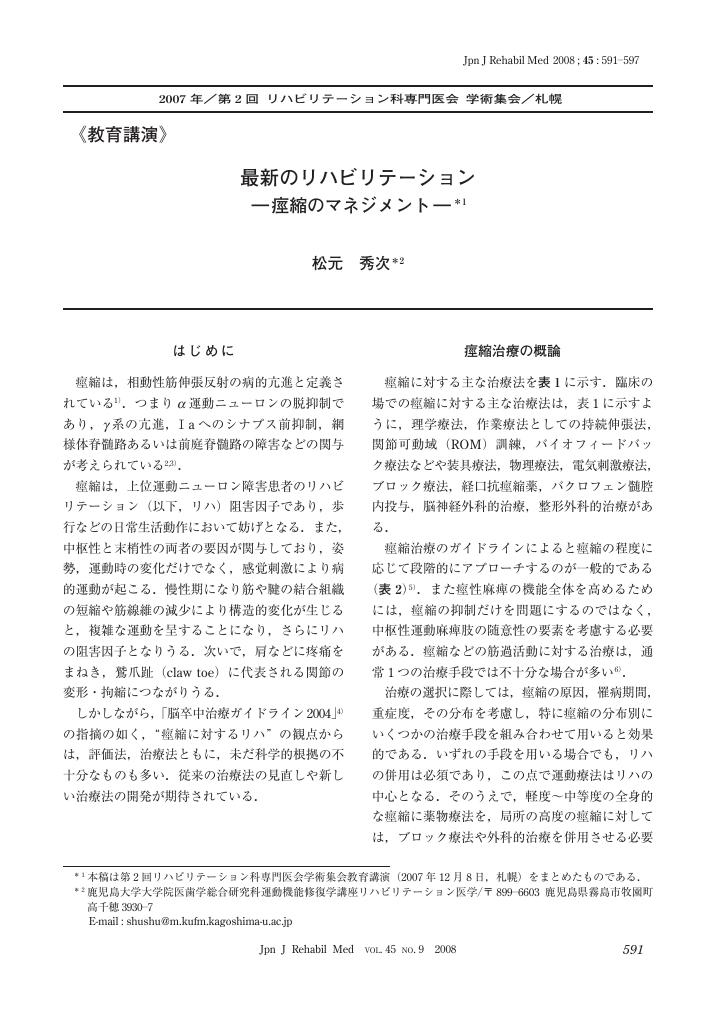2 0 0 0 OA 最新のリハビリテーション
- 著者
- 松元 秀次
- 出版者
- 公益社団法人 日本リハビリテーション医学会
- 雑誌
- The Japanese Journal of Rehabilitation Medicine (ISSN:18813526)
- 巻号頁・発行日
- vol.45, no.9, pp.591-597, 2008-09-18 (Released:2008-10-01)
- 参考文献数
- 22
2 0 0 0 OA 脳卒中片麻痺患者への 3 種の麻痺側荷重指導が歩行に及ぼす影響について
- 著者
- 上間 智博 松元 秀次 種田 沙織 竹下 可奈子 川平 和美
- 出版者
- 日本義肢装具学会
- 雑誌
- 日本義肢装具学会誌 (ISSN:09104720)
- 巻号頁・発行日
- vol.27, no.2, pp.105-111, 2011-04-01 (Released:2013-09-15)
- 参考文献数
- 15
脳卒中片麻痺患者の歩行は非対称性を特徴としているにもかかわらず,歩行指導は対称性歩行を目指して麻痺側へ荷重を促す方法が一般的である.本研究は,片麻痺患者の歩行について,麻痺側下肢への荷重をコントロールした 3 種の歩行パターンで歩行効率の検証を行った.対象は脳卒中片麻痺患者 16 名で,短下肢装具とT字杖を使用し,少なくとも監視レベルで歩行可能な症例とした.評価は 10 m 歩行における速度とケイデンス,ビデオ画像の動作解析による歩行立脚期の側方変位距離,歩行パターンによる歩行周期の変化(健側と麻痺側の立脚期割合,単脚支持期割合,1 歩時間,歩幅の患側/健側比,重複歩時間)を行った.3 種の歩行パターンのうち非対称性歩行(健側優位歩行)に比べ,対称性歩行(麻痺側歩行)が歩行速度,歩行立脚期の側方変位距離,歩行周期の変化で歩行効率低下を示した.以上のことから,過度に麻痺側へ健側と同様に荷重することは重心移動を妨げ,歩行速度や歩行効率低下につながると推察される.
1 0 0 0 OA 脳梗塞のリハビリテーション治療
- 著者
- 松元 秀次
- 出版者
- 日本医科大学医学会
- 雑誌
- 日本医科大学医学会雑誌 (ISSN:13498975)
- 巻号頁・発行日
- vol.15, no.4, pp.201-209, 2019-10-15 (Released:2019-12-03)
- 参考文献数
- 18
Stroke is clinically characterized by hemiplegia and exercise intolerance, both of which not only interfere with the ability to perform activities of daily living (ADL), but also significantly reduce quality-of-life (QOL). Neurological and functional recovery occurs mainly within the first 6 weeks after onset of stroke, but the process continues for several months, with maximal functional recovery usually achieved within 6 months. In Japan, convalescent rehabilitation wards play an important role in the rehabilitation of post-stroke patients who have impaired ADL and health status after the acute phase. Various physiotherapies have been developed to improve functional recovery in patients with hemiplegia due to stroke, including the facilitation technique with proprioceptive neuromuscular facilitation, and constraint-induced movement therapy. A novel facilitation technique is repetitive facilitative exercises (RFE), which promote the functional recovery of the hemiplegic limbs to a greater extent than conventional rehabilitation sessions.Functional electrical stimulation (FES) is a technique used to produce contractions in paralyzed muscles by the application of small pulses of electrical stimulation to the nerves that supply the paralyzed muscle. FES is used as an orthosis to assist walking, and also as a means of practicing functional movements for therapeutic benefit. New training technologies involving the use of robots have recently been developed to help in the rehabilitation of post-stroke patients.Robot-assisted rehabilitation therapy provides functional training of the upper and lower limbs in an effective, easy and comfortable manner. Furthermore, the robot-assisted training paradigm offers intensive, repetitive, sufficient, and accurate kinematic feedback along with symmetrical practice while reducing the workload for the therapist, thus reducing the cost of post-stroke rehabilitation. Exoskeleton-type robotic devices have robot axes aligned with the anatomical axes of the wearer. These robots provide direct control over individual joints, which can minimize abnormal posture or movement. Robot-assisted gait training is effective in the long term in improving balance and walking ability, and it has a positive impact on patients' QOL. Several well-designed studies have provided evidence that robot-assisted training promotes motor recovery and functional improvement in post-stroke patients. However, the evidence is insufficient to draw conclusions about the effectiveness because of small samples sizes, methodological flaws, and heterogeneous training procedures. More well-designed randomized controlled trials are needed.
- 著者
- 宮良 広大 松元 秀次 上間 智博 廣川 琢也 野間 知一 池田 恵子 下堂薗 恵 川平 和美
- 出版者
- 公益社団法人日本理学療法士協会
- 雑誌
- 理学療法学 (ISSN:02893770)
- 巻号頁・発行日
- vol.42, no.2, pp.90-97, 2015-04-20 (Released:2017-06-09)
【目的】脳卒中片麻痺下肢への全身振動刺激(Whole body vibration;以下,WBV)による痙縮抑制メカニズム解明のために,脊髄前角細胞の興奮性評価に用いられる誘発電位F波(以下,F波)を測定し検討した。【方法】対象は下肢痙縮を有する脳卒中片麻痺患者10名。WBV実施姿勢は股関節90°屈曲位,膝関節伸展位0°で長座位とした。WBVは下腿三頭筋とハムストリングスを中心に,周波数30Hz,振幅4〜8mmの条件で5分間実施した。WBV前後にModified Ashworth Scale(以下,MAS)とF波,足関節自動および他動関節可動域,10m歩行テストを測定した。【結果】MASは有意に低下し,足関節自動背屈角度と他動関節可動域,歩行能力が有意に改善した。さらにF波振幅で低下傾向,F/M比で有意な低下を認めた。【結論】WBVによる痙縮抑制メカニズムとして脊髄前角細胞の興奮性低下の関与が示唆された。
1 0 0 0 OA 歩行障害のリハビリテーション治療―神経筋電気刺激装置―
- 著者
- 松元 秀次 小林 美香
- 出版者
- 公益社団法人 日本リハビリテーション医学会
- 雑誌
- The Japanese Journal of Rehabilitation Medicine (ISSN:18813526)
- 巻号頁・発行日
- vol.55, no.9, pp.751-756, 2018-09-18 (Released:2018-10-29)
- 参考文献数
- 16
- 被引用文献数
- 4
電気刺激は,治療的電気刺激(TES)と機能的電気刺激(FES)に大きく分類される.神経筋電気刺激(NMES)はTESに含まれ,運動機能障害に対して神経支配筋の筋収縮を目的とした電気刺激を指す.電気刺激装置には,TES・FESの両方のモード設定ができるものがあるため,医療承認機器の名称も含めて十分理解しておく必要がある.中枢神経障害による麻痺や痙縮の改善,末梢神経損傷による神経原性筋萎縮などがNMESの適応であり,いずれにしても運動療法を併用することで治療効果を促進することができる.機器の特徴を知っていれば,下肢機能回復を図る電気刺激療法として,また歩行障害に対する電気刺激療法として装具の代行効果だけでなく,運動機能改善効果が期待できる.
1 0 0 0 OA 内在筋に着目した中指橈側尺側外転訓練
- 著者
- 我妻 朋美 萩原 祐介 伏屋 洋志 菅野 麻希 高橋 美香 松元 秀次
- 出版者
- 日本医科大学医学会
- 雑誌
- 日本医科大学医学会雑誌 (ISSN:13498975)
- 巻号頁・発行日
- vol.14, no.3, pp.125-130, 2018-06-15 (Released:2018-08-08)
- 参考文献数
- 7
Background: We have observed that patients with restricted thumb opposition sometimes develop dysfunction of the intrinsic muscles around the metacarpal joint of the middle finger. Therefore, we developed a middle finger abduction exercise program which focuses on improvement of intrinsic muscle function during post-operative rehabilitation after thumb carpometacarpal arthroplasty. We report on the efficacy of the program herein.Methods: Three patients with Eaton stage III-IV thumb carpometacarpal arthritis were included in the study. The effects of the exercise program were recorded. Ultrasonography and surface electromyography were used to evaluate the effects of the exercise in two healthy volunteers.Results: Five minutes of exercise resulted in a 1- to 2-point improvement in the Kapandji opposition score, and a 1- to 3-cm improvement in thumb opposition to the base of the small finger. Ultrasonography and electromyography revealed that adductor pollicis, abductor pollicis brevis, opponens pollicis, and abductor digiti minimi contractions became more synchronous.Conclusion: Our middle finger abduction exercise program improves thumb opposition significantly. The program may be particularly useful for post-operative rehabilitation after thumb surgeries: thumb opposition can be improved without thumb motion, which can be painful in the early post-operative period.
1 0 0 0 OA 嚥下障害に対する高電圧パルス電流を用いた電気刺激療法の効果
1 0 0 0 少年フェンサーのスポーツ障害について
- 著者
- 森 修 松元 秀次
- 出版者
- 日本臨床スポーツ医学会
- 雑誌
- 日本臨床スポーツ医学会誌 = The journal of Japanese Society of Clinical Sports Medicine (ISSN:13464159)
- 巻号頁・発行日
- vol.10, no.3, pp.463-465, 2002-08-10
